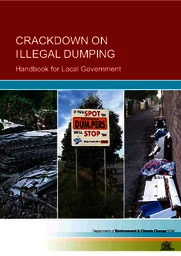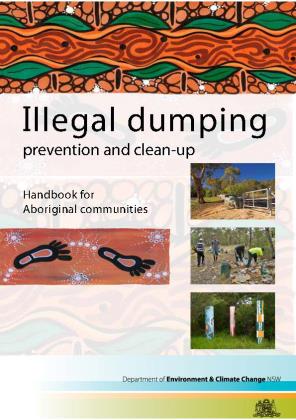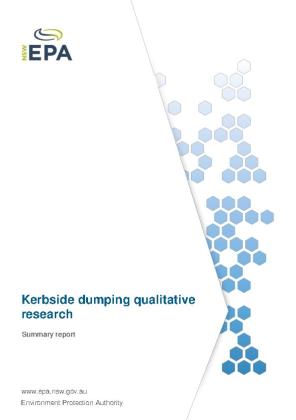Understand your illegal dumping problem
Gathering information about illegal dumping is challenging. Dumping is often done in remote areas, and dumpers try to keep it out of sight, undetected and anonymous. But accurate, comprehensive data will help direct and prioritise action. It will tell you how big the problem is, where the problems are and what is dumped.
RIDonline is the illegal dumping database and reporting tool for New South Wales. It allows agencies to record and manage illegal dumping incidents, and map and report on trends. The online database is freely available to public land managers. The data from RIDonline will help inform your illegal dumping prevention programs by identifying hotspots and trends, such as the most commonly dumped type of waste or average tonnes dumped. It can also help you justify your programs by determining how much it costs you to clean-up.
Our social research can be used to develop programs, as it helps us understand what motivates illegal dumpers so we can change behaviour and who our target audience is.
Develop a great project
To run an effective illegal dumping prevention program, you need to
- understand your illegal dumping problem before you act
- use a mix of six approaches
- make doing the right thing easier
- engage partners
- targeted communication
- clean-up
- reduce access
- increase enforcement
- know how you will measure your projects effectiveness (an evaluation plan)
- find partners to help
- celebrate your achievements
The EPA offers grant funding and support for illegal dumping prevention projects to councils, other government agencies, community groups, local aboriginal lands councils and charitable recyclers. To find out more about funding criteria and how to apply visit our grants page.
You can use our resources to deter dumpers, increase reporting and create awareness of the issue. You can also use successful projects (case studies) to inform the development of your prevention project. By using a whole of Council approach, you can increase your resources and create a more successful project.
Case Studies
- Extending council capacity by engaging outdoor staff – City of Botany Bay Council
- Benefits of a whole-of-council approach – Port Stephens Council
- Collaborating across departments to reduce dumping – City of Canada Bay
Increasing awareness of illegal dumping
- Make your community aware of the issues and encourage them to report illegal dumping and suspicious behaviour
- Carry out education programs to tell the community about how to manage their waste and the penalties for illegal dumping.
- Publicise your project through, for example, local media releases.
- Engaging the community through Clean Up Australia Day
Case Study
- Engaging transient tenants – Waverley Council
Use prevention measures
Prevention and deterrence are central to reducing illegal dumping. Make it hard for dumpers to enter your land by installing physical barriers, such as earth mounds, fencing, locked gates and lighting.
- Sites with limited or no public access could be permanently closed by gates, fences or planted vegetation.
- Sites with public access can use deterrence methods such as signage and surveillance devices.
- Sites where small loads of household waste are being dumped, usually from cars and trailers, can be deterred by using cabled concrete blocks or bollard fencing and gates.
- Use landscaping, revegetation and beautification to foster community pride in your land and enhance the area's aesthetic appeal.
Case studies
- Using landscaping works to remove opportunities for dumpers – Woollahra Council
- Deterring residential dumpers using a strategic approach – Ashfield Council
Estimate the cost of your prevention measures
- Obtain quotes for installing each prevention option you are considering. Compare a variety of prevention techniques to assess the cost-effectiveness of a solution.
- Check what specialist heavy machinery is needed for installing and maintaining physical barriers.
- Determine how much time will be consumed by staff and volunteers for each option.
- Some measures will require initial short-term installation costs and then longer term maintenance or repairs. Factor in maintenance costs or select vandal-resistant materials.
Make sites clean
Cleaning up illegally dumped waste is important as it sends the message that waste does not belong there, and removes environmental and health risks. Keeping sites clean reduces the risk of more dumping. You must ensure the dumped waste is safely removed and transported to a waste disposal or recycling facility that can lawfully receive it. You can also record the incident on RIDonline.
If choosing a waste contractor, make sure they are reputable. If a quote for managing waste is low, find out why. The company may be avoiding costs by transporting the waste to a place that cannot lawfully accept it. Ensure the waste contractor
- will provide copies of disposal dockets so you can check the waste is taken to a legal waste or recycling facility
- if in doubt, phone the facility and ask if they accept the type of waste you are transporting or check the POEO public register see if the facility has an EPA licence
Run effective illegal dumping enforcement campaigns
Councils and other government agencies have the power to investigate and penalise illegal dumpers. Taking enforcement action as part of an overall illegal dumping prevention strategy that includes education and prevention infrastructure can play a big role in reducing illegal dumping. You can increase the risk of dumpers getting caught by
- Strengthen surveillance and patrolling by using cameras and signs (PDF 3.2MB) to indicate the area is being watched, patrolling hotspots and encouraging community members to report instances of illegal dumping.
- Install lighting and design landscaping to help increase offenders’ visibility.
Carry out periodic high-profile compliance or enforcement action.
Case studies
- Adapting surveillance techniques to deter different dumpers – Ryde Council
- Combatting commercial dumpers – Blacktown City Council





